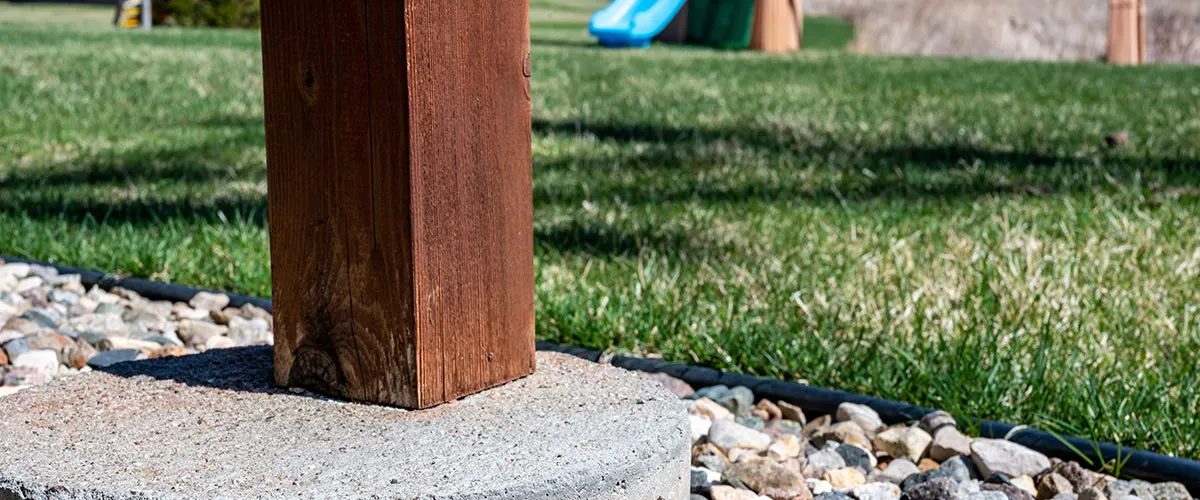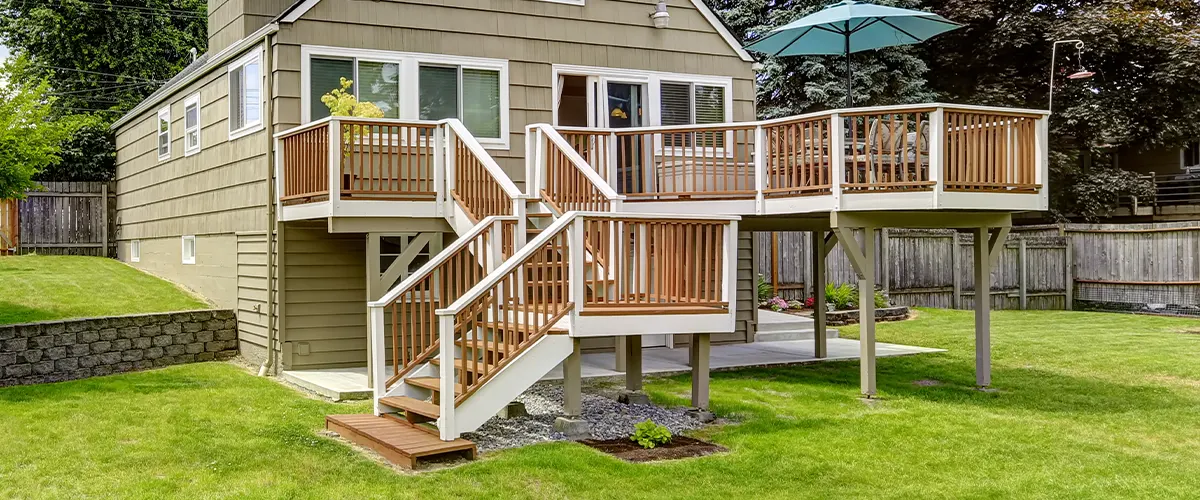Deck Footings for Success: Guaranteeing a Strong and Long Lasting Deck Structure
Deck Footings for Success: Guaranteeing a Strong and Long Lasting Deck Structure
Blog Article
Enhance Your Deck's Stability With Appropriate Deck Ground: Ensure Durable Durability and Security
When it pertains to constructing a deck, guaranteeing its security and durability is of utmost relevance. One key element that commonly obtains forgotten is the correct installation of deck footings. These footings serve as the foundation of your deck, supplying the needed assistance and security to withstand the examination of time. By recognizing the impact of dirt problems and picking the ideal products, you can boost your deck's security and guarantee its resilient toughness and safety and security. So, just how exactly do you go around attaining this? In this discussion, we will explore the importance of correct deck ground, guide you through the step-by-step process of installation, and highlight the relevance of normal upkeep to protect your deck's stability.
Why Proper Deck Ground Matters
Correct deck footing is critical for making certain the stability and lasting toughness of any deck framework. The deck footing, or foundation, functions as the anchor factor for the entire deck, sustaining the weight of the structure and transferring it to the ground below - Deck Footings. Without a solid footing, a deck can come to be unstable, bring about structural failing and possible security risks

In addition, proper deck footing assists to shield versus moisture damage. Wetness can permeate right into the ground and weaken the foundation, bring about rotting or decay. By utilizing suitable products and strategies for the ground, such as helical piles or concrete piers, the deck can be elevated over the ground, lessening contact with dampness and extending its life-span.
Comprehending the Influence of Dirt Conditions
The stability and longevity of a deck framework can be greatly affected by the soil conditions in which it is built. Understanding the impact of soil conditions is critical for guaranteeing the resilient longevity and safety and security of a deck. Various sorts of dirt have varying load-bearing capabilities, drain abilities, and growth and contraction homes, which can all impact the stability of the deck.
One vital factor to consider is the dirt's bearing ability, which refers to its ability to support the weight of the deck and any type of extra tons. Soils with high bearing abilities, such as compressed gravel or clay, are perfect for supporting heavy structures like decks. On the various other hand, dirts with low bearing abilities, such as loosened sand or soft clay, may call for added procedures to enhance security, such as deep grounds or soil stablizing methods.

In addition, the soil's propensity to contract and increase with changes in wetness content can affect the security of the deck. Soils with high clay web content are prone to considerable growth and contraction, which can result in changing and working out of the deck structure. Correct steps, such as mounting moisture barriers or utilizing alternate foundation systems, might be required to alleviate the effects of soil activity.
Choosing the Right Ground Materials
What elements should be taken into consideration when selecting the suitable ground products for a deck? Selecting the appropriate ground materials is necessary for ensuring the stability and durability of a deck. When making this decision., a number of variables require to be taken into consideration.
Firstly, the kind of soil in the location plays a critical role in identifying the suitable footing materials. Different soils have varying load-bearing capabilities, so it is essential to choose products that can properly support the weight of the deck and any type of prospective tons it may bear.
Secondly, the climate and weather condition conditions of the area must be taken into consideration. In areas with severe wintertimes or visit the site high levels of moisture, footing materials that are immune to deterioration and degeneration, such as concrete or cured wood, are suggested. These products are a lot more long lasting and much less susceptible to damage from freezing temperatures, dampness, and bugs.
In addition, the dimension and height of the deck also affect the selection of footing products. Larger and taller decks call for even more significant grounds to make sure stability and prevent sinking or changing. In such situations, products like concrete footings or helical piers might be preferable.
Last but not least, spending plan considerations should not be forgotten. While some products may supply remarkable sturdiness and performance, they may he said also feature a higher price. When selecting the ideal footing products for a deck., it is essential to strike an equilibrium between price and high quality.
Step-by-Step Guide to Putting Up Deck Footings
When installing deck grounds, it is very important to adhere to a step-by-step overview to ensure security and resilience. By adhering to these steps, you can make sure that your deck will have the ability to endure the examination of time and provide a pleasurable and secure outdoor area for several years to come.
The initial step in installing deck grounds is to establish the location and design of your deck. This consists of measuring and noting the area where the footings will certainly be positioned. It is very important to make sure that the grounds are evenly spaced and aligned with the deck's style.
Following, you will certainly need to dig the holes for the footings. The deepness and size of the openings will certainly depend on the size and weight of your deck. It is important to dig the openings deep sufficient to get to below the frost line to avoid frost heave.
Once the holes are dug, you can begin putting the concrete grounds. Make use of a post level to ensure that the footings are plumb.
After the grounds have actually been put, enable the concrete to treat for at the very least two days before proceeding with the deck installment. This will certainly make sure that the grounds have solidified and are prepared to support the weight of the deck.
Regular Upkeep to Maintain Deck Stability
To maintain the security of your deck, routine maintenance is crucial. By applying a routine upkeep timetable, you can guarantee that your deck remains secure, resilient, and aesthetically attractive. One important aspect of upkeep is inspecting the deck for any kind of indications of damage or wear. This includes monitoring for loose or broken boards, rusted nails or screws, and any kind of indications of rot or degeneration. It is crucial to address these concerns quickly to protect against additional damages and prospective safety and security dangers.
Cleansing your deck regularly is another essential maintenance task. Furthermore, on a regular basis using a safety sealer can assist avoid wetness damage and prolong the life of your deck.
Along with these regular maintenance jobs, it is also recommended to carry out a detailed examination of the deck's structural parts a minimum of yearly. This consists of examining the problem of the footings, messages, beams, and joists. Any type of signs of damage or weakness should be resolved without delay to guarantee the ongoing stability and safety of the deck.
Final Thought
Finally, proper deck ground is necessary for making sure the lasting resilience and safety of your deck. Recognizing the impact of dirt conditions and picking the ideal footing products are essential action in this process. By adhering to a step-by-step overview to setting up deck grounds and on a regular basis maintaining them, you can boost your deck's stability. Inevitably, these steps will certainly help protect your deck's integrity and make sure a enjoyable and risk-free outdoor review area for several years to find.
In this conversation, we will certainly explore the significance of correct deck ground, overview you through the step-by-step process of installment, and highlight the relevance of regular maintenance to protect your deck's security.
Correct deck ground is crucial for guaranteeing the security and long-term toughness of any kind of deck framework.One of the key reasons why proper deck footing matters is to avoid the deck from moving or sinking over time (Deck Footings).In verdict, correct deck ground is crucial for ensuring the long-lasting resilience and security of your deck. By complying with a step-by-step guide to installing deck footings and routinely maintaining them, you can enhance your deck's stability
Report this page